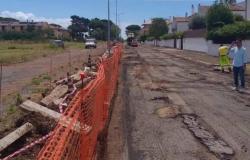The price of European natural gas remains at the levels of the previous closing, after the rise triggered by the discovery of one leak in a pipeline in the North Sea which transports the raw material from Norway. The interruption of flows highlights the partial dependence on the Nordic country, which replaced Russia as the main gas supplier after the outbreak of the war in Ukraine. Despite the high levels of storage, the market remains sensitive to supply problems and prices may fluctuate markedly.
European natural gas at six-month highs
On Monday, i gas futures listed on the TTF (“Title Transfer facility”, the virtual trading point for natural gas in the Netherlands) they closed up 5.2% at 36.01 euros per megawatt hour.
During the session, i prices have recorded increases of up to 13%, reaching 38.56 euros/megawatt hour, the highest in six months. At the moment, they travel little and fluctuate around €36/MWh.
Sleipner platform failure
What triggered yesterday’s leap was one crack in a pipeline connecting the Sleipner Riser platform in the North Sea (operated by Equinor) to the Nyhamna shore facilitywhere the gas is processed before export to the UK terminal at Easington, the entry point for a third of Britain’s total supply.
The problem with the pipeline emerged during an inspection which highlighted a significant fault, which solution may take time. It is difficult to identify the cause of the problem, but according to initial assessments it should simply be wear and tear.
The Norwegian network operator Gassco he made it known that is collaborating with Equinor to divert at least part of the flowsin order to “deliver the maximum possible volumes to Europe”where the damage would lead to a prolonged interruption.
Dependence on Norway for gas supplies
Yesterday’s event highlights the risk of relying too much on a single large supplier. From 2022, in fact, the Norway took over from Russia as primary source of gas for Europefollowing the Russian invasion of Ukraine and the resulting Western sanctions against Moscow.

Previously, the Kremlin supplied about a third of Europe’s total gas. Now instead the region depends to a greater extent from Norwegian flows and from liquefied natural gas (LNG) from the United States and Qatar.
In recent weeks, LNG imports into Europe have fallen due to higher demand in Asia, where a heat wave is boosting cooling consumption. This is spurring competition for cargo, as highlighted by Ole Hansen, commodities expert at Saxo Bank.
Meanwhile, the annual maintenance work on the TurkStream gas pipeline began today, which will deprive the Old Continent of further Russian flows for a week.
High gas storage levels, but risks remain
Storage levels in Europe are reassuring, with i warehouses full to more than 70 percent of their total capacity, a level historically exceeded only once at this time of year, thanks also to the relatively mild winter that passed. Furthermore, industrial demand is recovering slowly, putting little pressure on consumption.
However, the market remains volatile and sensitive to any changes in supplies and to changes in scheduled maintenance plans.
According to analysts at Goldman Sachs, low European demand is expected to keep storage levels high throughout the summer. In this scenario, i gas prices are expected to be around €30/Mwhslightly decreasing compared to current prices. Ahead of winterHowever, the region remains vulnerable to possible threats temperatures lower than averageThat could lead to a rapid increase in gas prices.





